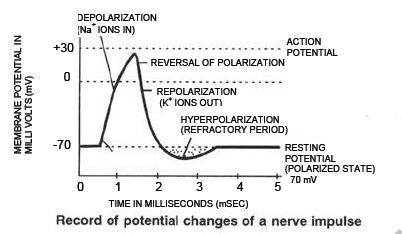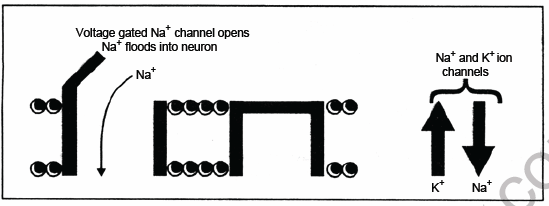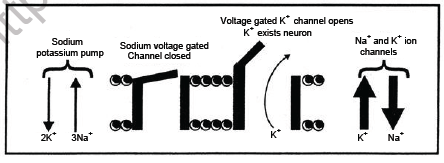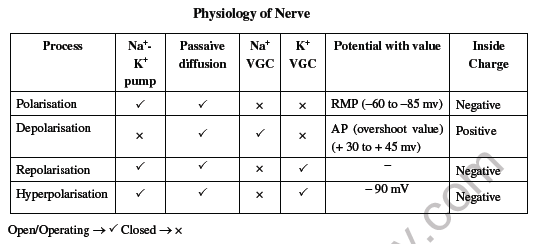NERVE IMPULSE INDUCTION :


The resting membrane potential in resting phase :
♦ The potential difference (a charge) which exists across the cell surface membrane of nerve cells is always, negative inside the cell with respect to the outside. The membrane is said to be polarised.
♦ The potential difference across the membrane at rest is called the resting membrane potential and this is about – 70mV (the negative sign indicates that inside the cell is negative with respect to the outside).
(Range – 60 to – 85 mV)
♦ The resting potential is maintained by active transport and passive diffusion of ions.
♦ Resting membrane potential is maintained by the active transport of ions against their electrochemical gradient by sodium potassium pump.
There are carrier protein located in the cell surface membrance. They are driven by energy supplied by ATP and couple the removal of three sodium ions from the axon with the uptake of two potassium ions.
The rate of diffusion is determined by the permeability of the axon membrane to the ion.
Potassium ions have a membrane permeability greater than that of sodium ions. Therefore potassium ions loss from the axon is greater than sodium ion gain. This leads to a net loss of potassium ions from
the axon, and the production of negative charge within the axon (organic anions).
Due to active transport (mainly) and diffusion process, positive charge is more outside and negative charge is more inside.
Outer covering of axolemma is positively charged and inner membrane of axolemma is negatively charged.

Depolarisation and Action potential :
Once the event of depolarization has occured, a nerve impulse or spike is initiated.
Action potential is another name of nerve impulse.
This is generated by a change in the sodium ion channels. These channels, and some of the potassium ion channels, are known as voltage gated channel, meaning they can be opened or closed with change in
voltage.
In resting state these channels are closed due to binding of Ca++.
An action potential is generated by sudden opening of the sodium gates. Opening of gates increases the permeability of the axon membrane to sodium ions which enter by diffusion.
This increases the number of positive ions inside the axon.
A change of –10mV in potential difference from RMP through influx is sufficiently significant to trigger a rapid influx of Na+ ions leading to generation of action potential.
This change of –10 mV is called as threshold stimulus.
At the point where membrane (Axolemma) is completely depolarised due to rapid influx of Na+ ions, the negative potential is first cancelled out and becomes 0 (Depolarisation). This axolemma is called as excited
membrane or depolarised membrane.
Due to further entry of Na+, the membrane potential "over shoots" beyond the zero and becomes positive upto + 30 to + 45mV.
This "over shoot" peak corresponds to maximum concentration of sodium inside the axon. This potential is called as action potential or spike potential. In this state, the inner surface of axolemma becomes positively charged and outer surface becomes negatively charged.

Repolarisation :
• After a fraction of second i.e., 0.5 m.sec, the sodium gates closed, Depolarisation of the axon membrane
causes potassium gates to open, potassium therefore diffuse out of cell.
• Since potassium is positively charged, this makes the inside of cell less positive, or more negative and the process of repolarization or return to the original resting potential begins.
• The repolarization period returns the cell to its resting potential (–70 mV). The neuron is now prepared to receive another stimulus and conduct it in the same manner.
• At this point membrane show hyper polarization.
• Sodium pump starts working to maintain the normal resting membrane potential by expelling Na+ and in take of K+.The time taken for restoration of resting potential is caled refractory period, because during this periods the membrane is incapable of receiving & conduicting another impulse.
• Nerve impulse travels as action potential which passes along axon as a wave of depolarization.
• The whole process of depolarisation and repolarisation is very fast. It takes only about 1 to 5 milli second (ms).


Saltatory conduction of nerve impuse :
→ This type of conduction occur in myelinated fibre. Myelin is fatty material with a high electrical resistance and act as electrical insulator in the same way as the rubber and plastic covering of electrical wiring.
– The combined resistance of the axon membrane and myelin sheath is very high, but where breaks in the myelin sheath occur known as nodes of Ranvier, the resistance to current flow between the axoplasm and the fluid outside the cell is low. It is only at these nodes local circuits are setup.
– This means, in effect that the action potential jump from node to node and passes along the myelinated axon faster as compared to the series of small local circuits in a non-myelinated axon. This type of conduction is called saltatory conduction.
– Leakage of ions takes place only in nodes of Ranvier and less energy is required for saltatory conduction.
Synaptic Transmission
Telodenria of one neutron form synapse with dendron of next neuron.
It is the junction between two neurons where information is transferred from one neutron to another neuron but no protoplasmic connection.
Synapse = Pre synaptic knob + synaptic cleft + post synaptic membrane
– Telodendria membrane is called pre synaptic membrane & membrane of dendron of other neuron called as post synaptic membrane. Space between pre and post synaptic membranes is called synaptic cleft.
– When the AP develop in pre synaptic membrane. it becomes permeable for Ca++.
– Ca++ enter in pre synaptic membrane & vesicles burst due to the stimulation by Ca++ and causes release of neurotransmitters (Ach) in synaptic cleft.
– Ach reaches the post synaptic membrane via synaptic cleft & bind to receptors. It develops excitatory post synaptic potential (EPSP). EPSP develop due to opening of Na+ gatted channnels
– Cholinesterase enzyme is found in the synaptic fluid of synapse.
– This enzyme decomposes the Ach into choline & Acetate.
– Neuro inhibitory transmitter (GABA) binds with post synaptic membrane to open the Cl– gated channels and hyperpolarization of neuron occurs. Now the potential is called inhibitory post synaptic potential (IPSP) & further nerve conduction is blocked.

